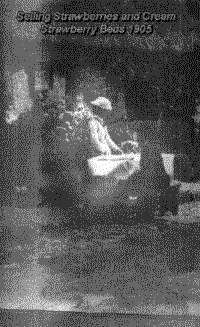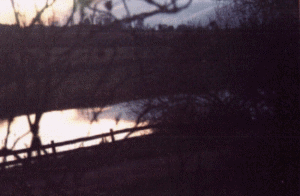

Special thanks to Jim Nolan for sending this to me.
THE STRAWBERRY BEDS,
"Passing out of the Phoenix Park by the Knockmaroon Gate, we enter the Lower Road, celebrated for its picturesque sylvan scenery. The northern bank of the river, rising abruptly from the roadside, forms a long range of sheltered slopes peculiarly adapted to the culture of strawberies, an industry identified with this place from time immemorial from which circumstance originated the name "The Strawberry Beds". On the opposite side of the river are gentle sloping stretches of luxuriant meadow and woodland, while along the water's edge the trees droop gracefully into the water, intermingling their foliage with the rank growth of aquatic vegetation.
 The Strawberry Beds was a much more popular resort in former years than at the
present day, and on fine Sundays in summer was visited by large numbers from
the city. Cars used to ply between Carlisle (now O'Connell) Bridge and "the
Beds" at 3d a seat, and were so well patronised that it was not an
infrequent sight to see a procession of these vehicles. amid blinding clouds
of dust, extending the whole way from Parkgate Street to Knockmaroon. The
outside cars, too, were longer in those days, and carried three passengers
on each side without any due compression, not to speak of two or three in
the well. The strawberry vendors, pipers, fiddlers, and publicans reaped a
rich harvest, the sounds of revelry filled the air, and when the shades of
night had fallen, numerous involuntary dismounts were made from the cars on
the homeward journey.
The Strawberry Beds was a much more popular resort in former years than at the
present day, and on fine Sundays in summer was visited by large numbers from
the city. Cars used to ply between Carlisle (now O'Connell) Bridge and "the
Beds" at 3d a seat, and were so well patronised that it was not an
infrequent sight to see a procession of these vehicles. amid blinding clouds
of dust, extending the whole way from Parkgate Street to Knockmaroon. The
outside cars, too, were longer in those days, and carried three passengers
on each side without any due compression, not to speak of two or three in
the well. The strawberry vendors, pipers, fiddlers, and publicans reaped a
rich harvest, the sounds of revelry filled the air, and when the shades of
night had fallen, numerous involuntary dismounts were made from the cars on
the homeward journey.
 About three miles from Knockmaroon, we pass, on the
right, the entrance gate to Luttrellstown, now the seat of Lord Annaly, and
formally the ancestral home of the Luttrells, on account of whose
performances there, and of the evil memories attaching to the place in the
consequence, the succeeding owners changed the name to Woodlands. A handsome
wooden bridge erected by Lord Carhampton once spanned the river opposite the
entrance gate, but was swept away by a flood in 1787.
About three miles from Knockmaroon, we pass, on the
right, the entrance gate to Luttrellstown, now the seat of Lord Annaly, and
formally the ancestral home of the Luttrells, on account of whose
performances there, and of the evil memories attaching to the place in the
consequence, the succeeding owners changed the name to Woodlands. A handsome
wooden bridge erected by Lord Carhampton once spanned the river opposite the
entrance gate, but was swept away by a flood in 1787.
Many pretty cottages are to be seen along the Lower Road but they suffer considerably from the dust caused by the traffic in summertime.
A short distance beyond the entrance gate to Luttrellstown are the Anna Liffey Mills , the successors of an edifice popularly known as "The Devil's Mills,"in consequence of the legend that it was erected in the course of a single night by his Satanic Majesty. We next pass a fine bridge leading into Lucan, which , however, is outside the limits of this excursion, and we keep straight ahead until an iron gate is seen in front, through which we enter the demesne of St.Catherine's. The avenue, which, for the most part is unfit for cycling, skirts the river bank for about a mile, shaded in parts by venerable trees, and at length diverges slightly towards the north as the ruins are approached. In the spring or early summer this demesne looks its best, as the numerous cherry trees are then showing their delicatly tinted blossoms, while in the sheltered glades may be seen a great profusion of wild flowers, of which the most conspicious is the wood anemone.
The first building we pass is the ruin of a chapel, evidently modern, which bears traces of renovation in parts, and whose walls, thickly overgrown with ivy, are embattled in a fantastic manner. Nothing appears to be known as to the origin of this nondescript structure.
Adjoining is the building popularly known as "Sarsfields Stables" but which is more probably portion of the out-offices of the old manor house of St.Catherines, purchased by Mr.La Touche in 1792, and dismantled by him to provide materials for a magnificent new mansion that was accidentally destroyed by fire in the early part of the last century. This beautiful residence was furnished in such a manner that it was said to be "all that money could accomplish or art produce."
The sequestered locality of St.Catherine's is the site of an ancient priory, founded in 1219 by Warrisius de Peche for the Canons of St.Victor, and dedicated to the saint whose name forms the present designation. The endowment proving in-adequate to maintain the establishment, the community in time became poor and oppressed with debts that they were unable to support themselves, and accordingly, in 1323, they assigned all their property to St.Thomas's Abbey Dublin, which continued in possesion of the religious house od St.Catherines until the Dissolution of the Monasteries. After the Dissolution it was granted to, and occupied as a residence by, Sir Nicholas White, Master of the Rolls in Queen Elizabeth's time. No trace whatever of the ancient building now survives, its site being probably covered by some portion of the modern residence of St.Catherine's."